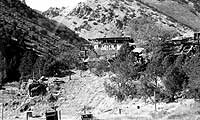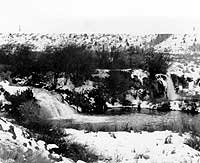|
Page
92
|

|
||
 |
||
| Generalized west-east geologic cross-section of the Lava Hot Springs area. Click on image for a larger view. |
Lava
Hot Springs and the Portneuf River
Lava
Hot Springs was deeded to the state in 1902 to provide a health and recreation
facility. The Lava Hot Springs area contains several hot springs which occur
along a north-south normal fault southwest of town and an east-west normal fault
which follows the Portneuf River canyon. The clear waters in gravel-bottomed
pools at the state-operated resort make for a wonderful, relaxing visit. The
east end of the pools are just as hot as a person can bear.
After the train depot was constructed in 1902-1905 the hot springs were accessible to the western traveler. The state built a natatorium in 1918 and now oversees operation of the swimming pools and hot baths through the Lava Hot Springs Foundation. The South Bannock County Historical Center located in the former Bank of Idaho building in Lava Hot Springs acts to preserve the heritage of the area.
On cold winter nights, when the steam of the hot springs reduces visibility to a few feet, people of all ages talk and play in perceived anonymity.Yet the city of Lava Hot Springs has been slow to take off as a recreational development. It has been for the last 30 years a quaint, tattered place, very much small-town southeast Idaho.
 |
 |
 |
| (left)
Ligertown, a ramshackle compound where dozens of lions, "ligers"(lion-tiger
crosses), and hybrid wolves were kept (October, 1995). In September 1995
some animals attacked the owners and escaped. Several were shot and the
owners were charged with numerous violations. The compound was destroyed
in April, 1996.
(center) Postcard of Lava Hot Springs, looking south from U.S.Highway 30, 1942. Abe Lillibridge collection, Idaho State University. (right) Waterfalls along the Portneuf River west of Lava Hot Springs, (January 1984). The falls cascade down terraces of algally deposited travertine, and the calcium carbonate deposits of hot springs. |
||